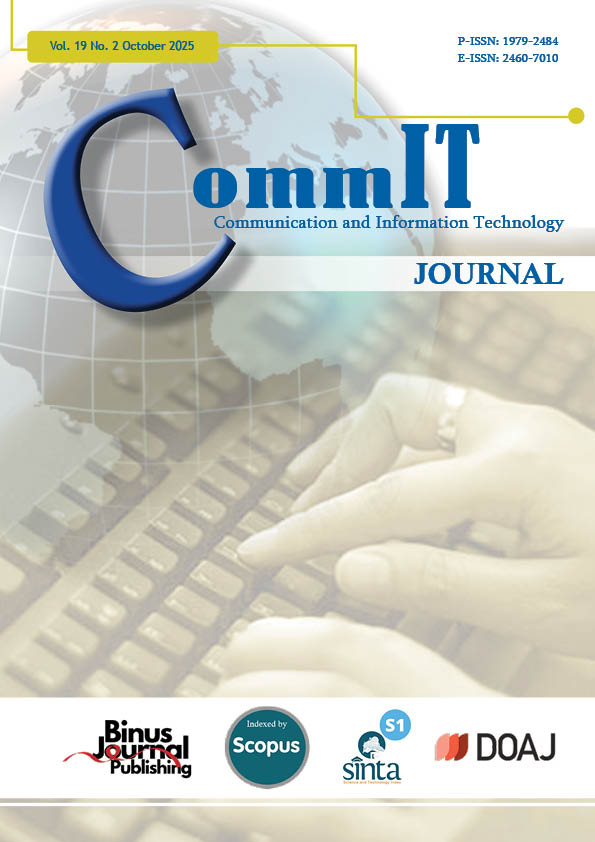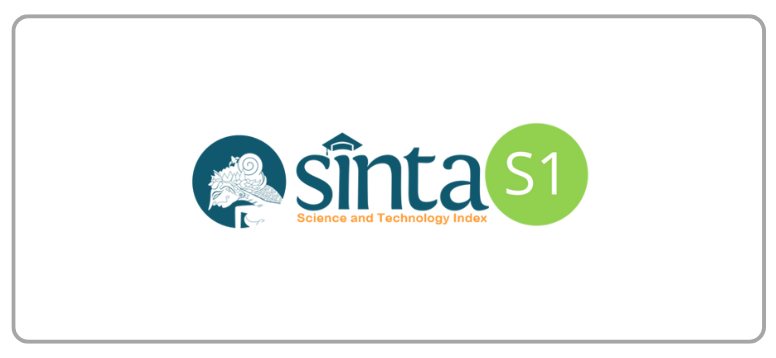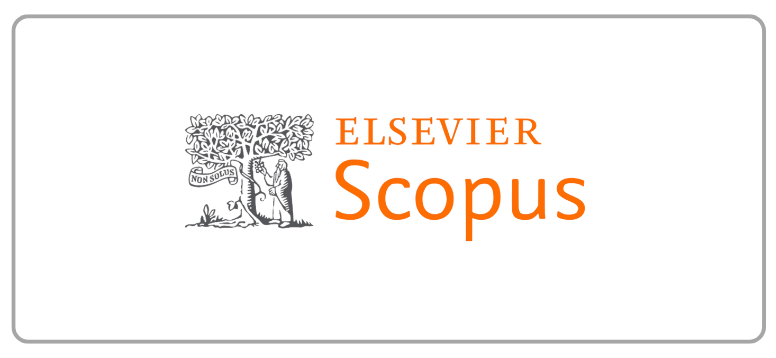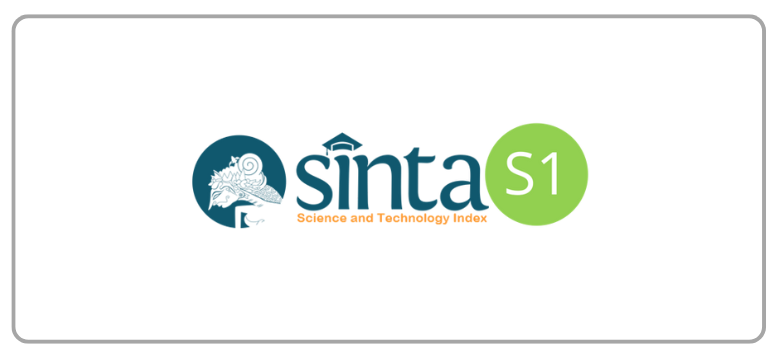Brain Tumor Segmentation Meets Efficiency: Res-UNet Improved by Attention Mechanisms and Quantization
DOI:
https://doi.org/10.21512/commit.v19i2.13177Keywords:
Brain Tumor Segmentation, Res-UNet, Attention Mechanisms, QuantizationAbstract
Brain tumor segmentation from Magnetic Resonance Imaging (MRI) images is a crucial step in medical diagnosis and treatment planning, which directly impacts clinical decision-making and patient outcomes, particularly in resource-constrained medical environments. However, achieving high segmentation accuracy while maintaining computational efficiency remains a challenge, particularly for complex tumor types. Therefore, the research aims to use the brain tumor segmentation dataset and the brain tumor MRI dataset from Kaggle to evaluate segmentation performance. The analysis also investigates the trade-off between model accuracy and efficiency by optimizing the Res-UNet architecture with attention mechanisms, including the Attention Gate (AG), Squeeze-and-Excitation (SE) Block, and the Convolutional Block Attention Module (CBAM). As the result, attention mechanisms improve feature representation and segmentation precision. Then, these procedures also add computational cost. To address this challenge, Dynamic Range Quantization (DRQ) compresses the model from 127 MB to 32 MB (75% reduction) and speeds up inference by 37% (0.3143 s to 0.1973 s). During the process, the best model, Res-UNet with AG, achieves a mean Intersection over Union (IoU) of 0.845 and drops only by less than 0.0004 after quantization. Unlike previous studies that explored attention or quantization in isolation, the researchers combine both to achieve accurate, efficient, and deployable brain tumor segmentation for resource-constrained settings.
References
[1] B. S. Gandhi, S. A. U. Rahman, A. Butar, and A. Victor, “Brain tumor segmentation and detection in Magnetic Resonance Imaging (MRI) using convolutional neural network,” in Brain tumor MRI image segmentation using deep learning techniques. Elsevier, 2022, pp. 37–57.
[2] S. He, Y. Feng, P. E. Grant, and Y. Ou, “Segmentation ability map: Interpret deep features for medical image segmentation,” Medical image analysis, vol. 84, 2023.
[3] C. M. Kumar and J. S. Sankar, “Comparative analysis of convolutional neural networks for brain tumor detection: A study of VGG16, ResNet, Inception, and DenseNet models,” in 2024 3rd International Conference on Applied Artificial Intelligence and Computing (ICAAIC). Salem, India: IEEE, June 5–7, 2024, pp. 41–46.
[4] L. Cao, J. Li, and S. Chen, “Multi-target segmentation of pancreas and pancreatic tumor based on fusion of attention mechanism,” Biomedical mSignal Processing and Control, vol. 79, 2023.
[5] P. K. Dash and D. S. Sisodia, “SEIMB-NET: A squeeze and excitation driven lightweight model for classification of brain tumors using magnetic resonance imaging,” in 2024 2nd World Conference on Communication & Computing (WCONF). Raipur, India: IEEE, July 12–14 2024, pp. 1–6.
[6] N. Shyamala and S. Mahaboobbasha, “Convolutional block attention module-based deep learning model for MRI brain tumor identification (ResNet-CBAM),” in 2024 5th International Conference on Smart Electronics and Communication (ICOSEC). Trichy, India: IEEE, Sep. 18–20, 2024, pp. 1603–1608.
[7] L. Huang, A. Miron, K. Hone, and Y. Li, “Segmenting medical images: From UNet to res-UNet and nnUNet,” in 2024 IEEE 37th International Symposium on Computer-Based Medical Systems (CBMS). Guadalajara, Mexico: IEEE, June 26–28, 2024, pp. 483–489.
[8] X. Li, Z. Fang, R. Zhao, and H. Mo, “Brain tumor MRI segmentation method based on improved Res-UNet,” IEEE Journal of Radio Frequency Identification, vol. 8, pp. 652–657, 2024.
[9] X. Fang, H. Liu, G. Xie, Y. Zhang, and D. Liu, “Deep neural network compression method based on product quantization,” in 2020 39th Chinese Control Conference (CCC). Shenyang, China: IEEE, July 27–29, 2020, pp. 7035–7040.
[10] J. Liu, L. Niu, Z. Yuan, D. Yang, X. Wang, and W. Liu, “PD-Quant: Post-training quantization based on prediction difference metric,” in Proceedings of the IEEE/CVF Conference on Computer Vision and Pattern Recognition, Vancouver, Canada, 2023, pp. 24 427–24 437.
[11] D. Choi, J. Park, and H. Kim, “HLQ: Hardwarefriendly logarithmic quantization aware training for power-efficient low-precision CNN models,” IEEE Access, vol. 12, pp. 159 611–159 621, 2024.
[12] Z. W. Awan, S. Khalid, and S. Gul, “A theoretical CNN compression framework for resourcerestricted environments,” in 2022 2nd International Conference on Digital Futures and Transformative Technologies (ICoDT2). Rawalpindi, Pakistan: IEEE, May 24–26, 2022, pp. 1–8.
[13] M. Singh, L. Mohanty, N. Gupta, Y. Bansal, and S. Garg, “Q-Net compressor: Adaptive quantization for deep learning on resource-constrained devices,” in 2024 International Conference on Computing, Sciences and Communications (ICCSC). Ghaziabad, India: IEEE, Oct. 24–25, 2024, pp. 1–6.
[14] J. Zhang, Z. Jiang, J. Dong, Y. Hou, and B. Liu, “Attention gate ResU-Net for automatic MRI brain tumor segmentation,” IEEE Access, vol. 8, pp. 58 533–58 545, 2020.
[15] A. F. M. M. Rahman and M. A. Hossain, “Attention-refined U-Net with skip connections for effective brain tumor segmentation from MRI images,” in 2023 26th International Conference on Computer and Information Technology (ICCIT). Cox’s Bazar, Bangladesh: IEEE, Dec. 13–15, 2023, pp. 1–6.
[16] T. Li, J. J. Liu, Y. Tai, and Y. Tian, “Brain tumor segmentation with attention-based U-Net,” in Second IYSF Academic Symposium on Artificial Intelligence and Computer Engineering, vol. 12079. Xi’an, China: SPIE, Oct. 8–10, 2021, pp. 147–155.
[17] Y. Z. Fang and J. D. Huang, “Enhancing brain tumor segmentation with deep supervision and attention mechanisms: Advances in the nnU-Net framework,” in 2024 IEEE International Symposium on Biomedical Imaging (ISBI). Athens, Greece: IEEE, May 27–30, 2024, pp. 1–4.
[18] Z. Wang, Y. Zou, and P. X. Liu, “Hybrid dilation and attention residual U-Net for medical image segmentation,” Computers in Biology and Medicine, vol. 134, 2021.
[19] X. Gan, L. Wang, Q. Chen, Y. Ge, and S. Duan,“GAU-Net: U-Net based on global attention mechanism for brain tumor segmentation,” Journal of Physics: Conference Series, vol. 1861, no. 1, pp. 1–8, 2021.
[20] D. Zhu, “Attention-based U-Net denoising network,” in 2023 IEEE International Conference on Sensors, Electronics and Computer Engineering (ICSECE). Jinzhou, China: IEEE, Aug. 18–20, 2023, pp. 746–750.
[21] K. Yamamoto, “Learnable companding quantization for accurate low-bit neural networks,” in Proceedings of the IEEE/CVF Conference on Computer Vision and Pattern Recognition, Virtual, June 19–25, 2021, pp. 5029–5038.
[22] S. Dai, R. Venkatesan, M. Ren, B. Zimmer, W. Dally, and B. Khailany, “VS-Quant: Per-vector scaled quantization for accurate low-precision neural network inference,” in Proceedings of Machine Learning and Systems 3 (MLSys 2021), vol. 3, 2021, pp. 873–884.
[23] A. S. Molahosseini and H. Vandierendonck, “Half-precision floating-point formats for PageRank: Opportunities and challenges,” in 2020 IEEE High Performance Extreme Computing Conference (HPEC). Waltham, MA, USA: IEEE, Sep. 22–24, 2020, pp. 1–7.
[24] Y. Jung, H. Kim, Y. Choi, and L. S. Kim, “Quantization-error-robust deep neural network for embedded accelerators,” IEEE Transactions on Circuits and Systems II: Express Briefs, vol. 69, no. 2, pp. 609–613, 2021.
[25] X. Wangl, Y. Zhong, and J. Dong, “A new lowbit quantization algorithm for neural networks,” in 2023 42nd Chinese Control Conference (CCC). Tianjin, China: IEEE, July 24–26, 2023, pp. 8509–8514.
[26] D. Upadhyay, S. Malhotra, M. Gupta, and S. Mishra, “Implementation of pruned and quantized semantic segmentation neural network using Cambridge-Driving Labeled Video Database (CamVid) dataset,” in 2024 2nd International Conference on Device Intelligence, Computing and Communication Technologies (DICCT). Dehradun, India: IEEE, March 15–16, 2024, pp. 1–6.
[27] M. AskariHemmat, S. Honari, L. Rouhier, C. S. Perone, J. Cohen-Adad, Y. Savaria, and J. P. David, “U-Net fixed-point quantization for medical image segmentation,” in International Workshop on Large-scale Annotation of Biomedical data and Expert Label Synthesis. Shenzhen, China: Springer, Oct. 13, 2019, pp. 115–124.
[28] X. Xu, Q. Lu, L. Yang, S. Hu, D. Chen, Y. Hu, and Y. Shi, “Quantization of fully convolutional networks for accurate biomedical image segmentation,” in Proceedings of the IEEE Conference on Computer Vision and Pattern Recognition, Salt Lake City, Utah, June 18–22, 2018, pp. 8300–8308.
[29] C. Qu, R. Zhao, Y. Yu, B. Liu, T. Yao, J. Zhu, B. A. Landman, Y. Tang, and Y. Huo, “Post-training quantization for 3D medical image segmentation: A practical study on real inference engines,” 2025. [Online]. Available: https://arxiv.org/pdf/2501.17343
[30] R. Zhang and A. C. S. Chung, “MedQ: Lossless ultra-low-bit neural network quantization for medical image segmentation,” Medical Image Analysis, vol. 73, 2021.
[31] C.W. Lin, Y. Hong, and J. Liu, “Aggregation-andattention network for brain tumor segmentation,” BMC Medical Imaging, vol. 21, pp. 1–12, 2021.
[32] R. T. Fernandes, G. R. Teixeira, E. C. Mamere, G. A. Bandeira, and A. E. Mamere, “The 2021 World Health Organization classification of gliomas: An imaging approach,” Radiologia Brasileira, vol. 56, pp. 157–161, 2023.
[33] G. Mahesh and K. M. Yogesh, “Brain tumor detection and classification using MRI images,” International Journal for Research in Applied Science & Engineering Technology (IJRASET), vol. 12, no. 10, pp. 856–863, 2024.
[34] K. R. Laukamp, F. Thiele, G. Shakirin, D. Zopfs, A. Faymonville, M. Timmer, D. Maintz, M. Perkuhn, and J. Borggrefe, “Fully automated detection and segmentation of meningiomas using deep learning on routine multiparametric MRI,” European Radiology, vol. 29, no. 1, pp. 124–132, 2019.
[35] D. Sreedhar, “Evaluating the clinical applicability of neural networks for meningioma tumor segmentation on multiparametric 3D MRI,” in 2024 International Conference on Machine Learning and Applications (ICMLA). Miami, FL, USA: IEEE, Dec. 18–20, 2024, pp. 1308–1313.
[36] A. B. Abdusalomov, M. Mukhiddinov, and T. K. Whangbo, “Brain tumor detection based on deep learning approaches and magnetic resonance imaging,” Cancers, vol. 15, no. 16, pp. 1–29, 2023.
[37] N. Tomar, “Brain tumor segmentation.” [Online]. Available: https://www.kaggle.com/datasets/nikhilroxtomar/brain-tumor-segmentation
[38] M. Nickparvar, “Brain tumor MRI dataset.” [Online]. Available: https://www.kaggle.com/datasets/masoudnickparvar/brain-tumor-mri-dataset/data
[39] S. F. Rabby, M. A. Arafat, and T. Hasan, “BT-Net: An end-to-end multi-task architecture for brain tumor classification, segmentation, and localization from MRI images,” Array, vol. 22, pp. 1–14, 2024.
[40] S. Saifullah and R. Dre˙zewski, “Redefining brain tumor segmentation: A cutting-edge convolutional neural networks-transfer learning approach,” International Journal of Electrical and Computer Engineering (IJECE), vol. 14, no. 3, pp. 2583–2591, 2024.
[41] N. Musthafa, M. M. Masud, and Q. Memon, “Advancing early-stage brain tumor detection with segmentation by modified Unet,” in Proceedings of the 2024 8th International Conference on Medical and Health Informatics, Yokohama, Japan, May 17–19, 2024, pp. 52–57.
[42] H. Alquran, M. Alslatie, A. Rababah, and W. A. Mustafa, “Improved brain tumor segmentation in MR images with a modified U-Net,” Applied Sciences, vol. 14, no. 15, pp. 1–16, 2024.
[43] J. Wang, S. Y. Lu, S. H. Wang, and Y. D. Zhang, “RanMerFormer: Randomized vision transformer with token merging for brain tumor classification,” Neurocomputing, vol. 573, pp. 1–12, 2024.
[44] M. M. Islam, P. Barua, M. Rahman, T. Ahammed, L. Akter, and J. Uddin, “Transfer learning architectures with fine-tuning for brain tumor classification using magnetic resonance imaging,” Healthcare Analytics, vol. 4, pp. 1–10, 2023.
[45] S. G. De Benedictis, G. Gargano, and G. Settembre, “Enhanced MRI brain tumor detection and classification via topological data analysis and low-rank tensor decomposition,” Journal of Computational Mathematics and Data Science, vol. 13, pp. 1–13, 2024.
[46] A. M. D. Simo, A. T. Kouanou, V. Monthe, M. K. Nana, and B. M. Lonla, “Introducing a deep learning method for brain tumor classification using MRI data towards better performance,” Informatics in Medicine Unlocked, vol. 44, pp. 1–24, 2024.
[47] J. Peng and Y. Wang, “Medical image segmentation with limited supervision: A review of deep network models,” IEEE Access, vol. 9, pp. 36 827–36 851, 2021.
[48] N. Siddique, S. Paheding, C. P. Elkin, and V. Devabhaktuni, “U-Net and its variants for medical image segmentation: A review of theory and applications,” IEEE Access, vol. 9, pp. 82 031–82 057, 2021.
[49] S. Mangayarkarasi, M. R. Asha, C. Kishore, M. Malathi, and V. Anitha, “Brain tumor segmentation using Res-Unet,” in 2024 International Conference on Smart Electronics and Communication Systems (ISENSE). Kottayam, India: IEEE, Dec. 6–7, 2024, pp. 1–6.
[50] Z. Jia, H. Zhu, J. Zhu, and P. Ma, “Two-branch network for brain tumor segmentation using attention mechanism and super-resolution reconstruction,” Computers in Biology and Medicine, vol. 157, 2023.
[51] D. M¨uller, I. Soto-Rey, and F. Kramer, “Towards a guideline for evaluation metrics in medical image segmentation,” BMC Research Notes, vol. 15, pp. 1–8, 2022.
[52] Q. Xia, H. Zheng, H. Zou, D. Luo, H. Tang, L. Li, and B. Jiang, “A comprehensive review of deep learning for medical image segmentation,” Neurocomputing, vol. 613, 2025.
[53] A. Raju and N. Sinha, “SSEGEP: Small segment emphasized performance evaluation metric for medical image segmentation,” Journal of Machine Learning in Fundamental Sciences, vol. 2022, no. 1, pp. 1–15, 2022.
[54] J. Schlemper, O. Oktay, M. Schaap, M. Heinrich, B. Kainz, B. Glocker, and D. Rueckert, “Attention gated networks: Learning to leverage salient regions in medical images,” Medical Image Analysis, vol. 53, pp. 197–207, 2019.
[55] X. Zhang, Y. Lin, L. Li, J. Zeng, X. Lan et al., “MA-ResUNet: Multi-attention optic cup and optic disc segmentation based on improved u-net,” IET Image Processing, vol. 18, no. 12, pp. 3128–3142, 2024.
[56] J. Hu, L. Shen, and G. Sun, “Squeeze-andexcitation networks,” in Proceedings of the IEEE Conference on Computer Vision and Pattern Recognition, Salt Lake City, Utah, June 18–22, 2018, pp. 7132–7141.
[57] S. Woo, J. Park, J. Y. Lee, and I. S. Kweon, “CBAM: Convolutional Block Attention Module,” in Proceedings of the European conference on computer vision (ECCV), Munich, Germany, Sep. 8–14, 2018, pp. 3–19.
[58] S. Cha, “Update on brain tumor imaging: From anatomy to physiology,” American Journal of Neuroradiology, vol. 27, no. 3, pp. 475–487, 2006.
[59] I. Blystad, J. B. M. Warntjes, O¨ . Smedby, P. Lundberg, E. M. Larsson, and A. Tisell, “Quantitative MRI using relaxometry in malignant gliomas detects contrast enhancement in peritumoral oedema,” Scientific Reports, vol. 10, no. 1, pp. 1–9, 2020.
[60] L. Yang, T. Wang, J. Zhang, S. Kang, S. Xu, and K. Wang, “Deep learning–based automatic segmentation of meningioma from T1-weighted contrast-enhanced MRI for preoperative meningioma differentiation using radiomic features,” BMC Medical Imaging, vol. 24, no. 1, pp. 1–12, 2024.
[61] N. H. Lu, Y. H. Huang, K. Y. Liu, and T. B. Chen, “Deep learning-driven brain tumor classification and segmentation using non-contrast MRI,” Scientific Reports, vol. 15, no. 1, pp. 1–24, 2025.
Downloads
Published
How to Cite
Issue
Section
License
Copyright (c) 2025 Kasiful Aprianto, Dwiza Riana

This work is licensed under a Creative Commons Attribution-ShareAlike 4.0 International License.
Authors who publish with this journal agree to the following terms:
a. Authors retain copyright and grant the journal right of first publication with the work simultaneously licensed under a Creative Commons Attribution License - Share Alike that allows others to share the work with an acknowledgment of the work's authorship and initial publication in this journal.
b. Authors are able to enter into separate, additional contractual arrangements for the non-exclusive distribution of the journal's published version of the work (e.g., post it to an institutional repository or publish it in a book), with an acknowledgment of its initial publication in this journal.
c. Authors are permitted and encouraged to post their work online (e.g., in institutional repositories or on their website) prior to and during the submission process, as it can lead to productive exchanges, as well as earlier and greater citation of published work.
Â
USER RIGHTS
All articles published Open Access will be immediately and permanently free for everyone to read and download. We are continuously working with our author communities to select the best choice of license options, currently being defined for this journal as follows: Creative Commons Attribution-Share Alike (CC BY-SA)




















